I have already discussed several times the ten Coptic fragments which were sold by Sotheby’s in July 2009. I was in Vienna when the auction took place and, as Cornelia Römer was at that time the director of the papyrus collection, she wanted to purchase the fragments for the Austrian National Library. That’s how I became aware that some new Coptic manuscripts were on the market.
However, it appeared that the fragments were purchased by somebody else so I lost track of them. It was only at the beginning of this year that Enzo Lucchesi drew to my attention that the same fragments were discussed by Federico Bottigliengo in 2009 in the magazine “Il collezionista,” which is published by the auction house Bolaffi in Turin. It was clear, therefore, that the Italian antiquarians must be the new owners of the fragments. Shortly thereafter, Bolaffi found about my interest in the material and they have kindly sent me digital photos of all the fragments which they acquired from Sotheby’s.
The paleographical examination that I made of them on the basis of the photographs confirmed that all the fragments came from codices which once belonged to the White Monastery in Upper Egypt. So far, I have managed to identify the following items from the Sotheby-Bolaffi lot:
Cyril of Alexandria, Scholia on the Incarnation of Monogenes (CPG 5225)
Pseudo-Cyril of Jerusalem, On the Passion of Christ, homily 1 (CPG 3598; clavis coptica 0114)
Pseudo-Cyril of Jerusalem, On the Finding of the True Cross (CPG 3602; clavis coptica 0120)
Pseudo-Evodius of Rome, On the Passion of Christ (clavis coptica 0149)
A few days ago, another interesting work came to light from those several fragments which were still unidentified. This is Bolaffi no. 4 and it contains a portion from the Acts of John in Coptic.
First of all, here is a picture of the fragment in question, which I received from Bolaffi:
THE IDENTIFICATION OF THE FRAGMENT
The text of this fragment is a portion from the so-called Metastasis (or Dormitio) Iohannis (CANT 215.2; BHG 910-913d). This work is in fact an extract from the Acts of John, more precisely the chapters 106-115. The events are placed in Ephesus, but unlike the account of John’s martyrdom which appears in some apocryphal acts, the Metastasis says that the apostle died of natural causes. Feeling that his time has come, John ordered his disciples to dig a grave. Then he stripped off his clothes, spread his hands, recited a long prayer and threw himself into the grave. The next morning when the disciples returned to the pit, John’s body disappeared and they found only one of his sandals.
This part of the Acts of John circulated independently in Greek and in most of the Eastern Christian languages, including Coptic (cf. BHO 476). A full version of the Sahidic text of Metastasis Iohannis was published by E.A.W. Budge from a manuscript in the British Library (at that time in the British Museum).[1] The text was re-edited after the comparison of the London codex with other fragmentary manuscript witnesses by Éric Junod and Jean-Daniel Kaestli in their edition of the Acts of John which appeared in the Corpus Christianorum. Series Apocryphorum collection.[2]
THE RECONSTRUCTION OF THE MANUSCRIPT
The library of the White Monastery (or the Monastery of Apa Shenoute as it is sometimes called) possessed several copies of Metastasis Iohannis, but unfortunately they survived only fragmentarily. It appears that this text was copied in the manuscripts after the Acts of John by Pseudo-Prochorus or was included in the miscellanies of the apocryphal acts of apostles. A directory of the latter collections was published by Enzo Lucchesi in the introduction to the book of Paul-Hubert Poirier, my doctoral advisor, concerning the Acts of Thomas in Coptic.[3]
The newly identified Bolaffi fragment belongs to one of these miscellanies containing apocryphal acts. It was torn from “codex C” according to Lucchesi’s classification,[4] which is codex MONB.MQ in the database Corpus dei manoscritti copti letterari.
As can be seen in the picture above (and below), Bolaffi no. 4 consists of the bottom of a parchment sheet. As I have shown several times on this blog, it may happen that one finds parts of the same leaf in different archives. That is also the case with this fragment from the Metastasis Iohannis, whose upper part is partly preserved in the collection of the Louvre Museum in Paris as E 10 015. The kinship between the two fragments is ascertained by the continuity of the text, which parallels Budge’s edition of the Coptic, pages 56-57:
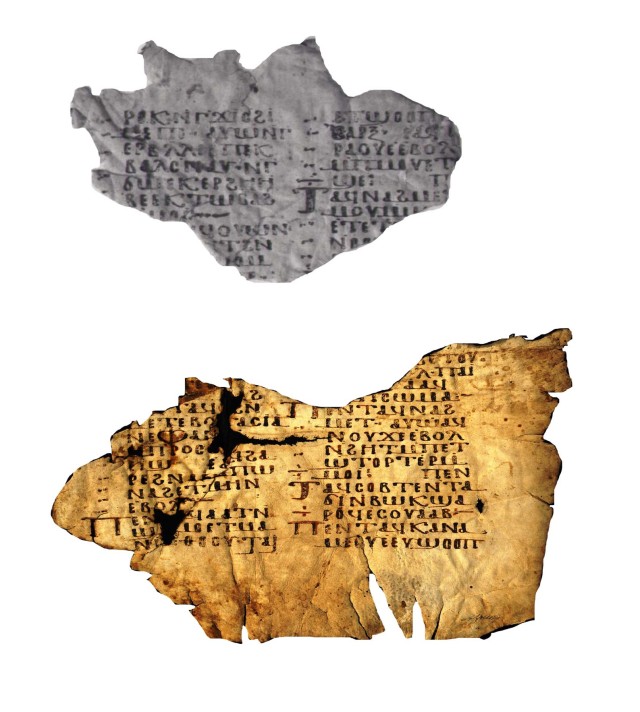 A stripe in the middle of the folio, which comprised eight lines or so, is still missing. Hopefully someone will find it one day.
A stripe in the middle of the folio, which comprised eight lines or so, is still missing. Hopefully someone will find it one day.
Although the pagination of the leaf hereby reconstructed is lost, we have available an important element which helps us to restore it with confidence. Thus, the textual continuity ascertains that a leaf which is preserved today in the papyrus collection of the Egyptian Museum in Berlin as P. Berol. 8772 immediately preceded Louvre 10 015 + Bolaffi no. 4 in codex MONB.MQ:
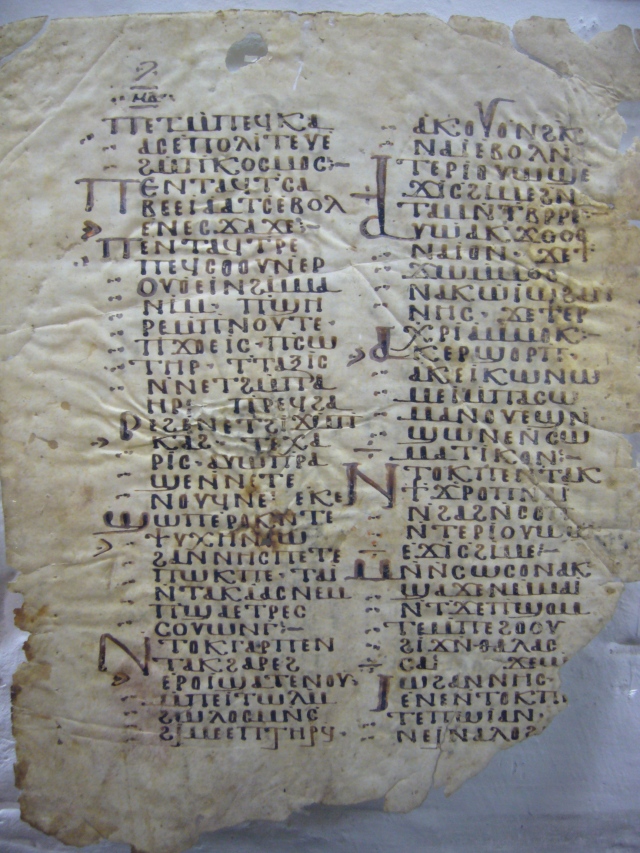 As the Berlin folio is paginated 43-44, the sheet formed by Louvre 10 015 + Bolaffi no. 4 must have been pages 45-46 of the same manuscript. This was already noticed by Lucchesi, who was the first who identified the content of the Louvre fragment.
As the Berlin folio is paginated 43-44, the sheet formed by Louvre 10 015 + Bolaffi no. 4 must have been pages 45-46 of the same manuscript. This was already noticed by Lucchesi, who was the first who identified the content of the Louvre fragment.
As to the age of the manuscript, another codex copied in the same scribe’s hand allows us to date it in the first half of the 10th century AD.
[1] E.A.W. Budge, Coptic Apocrypha in the Dialect of Upper Egypt (London: British Museum, 1913) 51-58 (Coptic text), 233-240 (English translation).
[2] E. Junod & J.-D. Kaestli, Acta Iohannis. Praefatio, Textus alii, Commentarius, Indices 2 vols. (Corpus Christianorum. Series Apocryphorum, 1-2; Turnhout: Brepols, 1983) 1: 376-397.
[3] E. Lucchesi, “Contribution codicologique au corpus copte des actes apocryphes des apôtres,” in P.-H. Poirier, La version copte de la Prédication et du Martyre de Thomas (Subsidia hagiographica, 67; Bruxelles: Societé des Bollandistes, 1984) 7-24.
[4] Ibidem, 14-15.

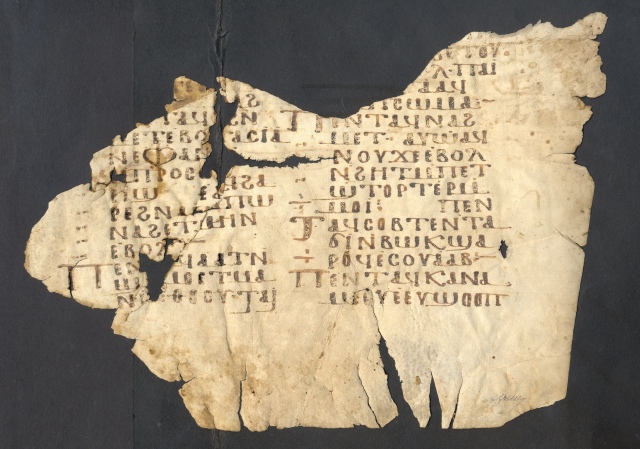








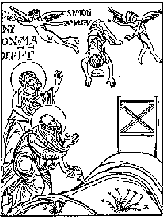




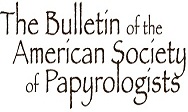
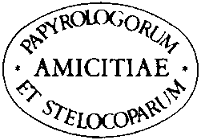
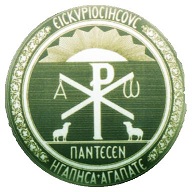





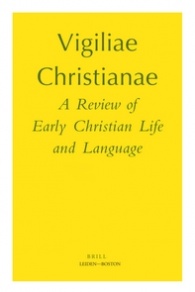






Pingback: Two Other Scraps from a Leaf Containing the Apocryphal Acts of John in Coptic | Alin Suciu
Pingback: Guest Post: Anthony Alcock – The Repose of St John the Evangelist and Apostle | Alin Suciu
I have five very similar fragments of coptic bible text on vellum aqcuired about 10 years ago. Are you interested to see these? I can send photo’s of them by email.